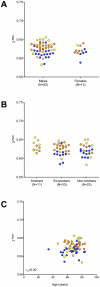Identification of miRNA-103 in the cellular fraction of human peripheral blood as a potential biomarker for malignant mesothelioma--a pilot study
- PMID: 22253921
- PMCID: PMC3256226
- DOI: 10.1371/journal.pone.0030221
Identification of miRNA-103 in the cellular fraction of human peripheral blood as a potential biomarker for malignant mesothelioma--a pilot study
Abstract
Background: To date, no biomarkers with reasonable sensitivity and specificity for the early detection of malignant mesothelioma have been described. The use of microRNAs (miRNAs) as minimally-invasive biomarkers has opened new opportunities for the diagnosis of cancer, primarily because they exhibit tumor-specific expression profiles and have been commonly observed in blood of both cancer patients and healthy controls. The aim of this pilot study was to identify miRNAs in the cellular fraction of human peripheral blood as potential novel biomarkers for the detection of malignant mesothelioma.
Methodology/principal findings: Using oligonucleotide microarrays for biomarker identification the miRNA levels in the cellular fraction of human peripheral blood of mesothelioma patients and asbestos-exposed controls were analyzed. Using a threefold expression change in combination with a significance level of p<0.05, miR-103 was identified as a potential biomarker for malignant mesothelioma. Quantitative real-time PCR (qRT-PCR) was used for validation of miR-103 in 23 malignant mesothelioma patients, 17 asbestos-exposed controls, and 25 controls from the general population. For discrimination of mesothelioma patients from asbestos-exposed controls a sensitivity of 83% and a specificity of 71% were calculated, and for discrimination of mesothelioma patients from the general population a sensitivity of 78% and a specificity of 76%.
Conclusions/significance: The results of this pilot study show that miR-103 is characterized by a promising sensitivity and specificity and might be a potential minimally-invasive biomarker for the diagnosis of mesothelioma. In addition, our results support the concept of using the cellular fraction of human blood for biomarker discovery. However, for early detection of malignant mesothelioma the feasibility of miR-103 alone or in combination with other biomarkers needs to be analyzed in a prospective study.
Conflict of interest statement
Figures






Similar articles
-
Circulating miR-132-3p as a Candidate Diagnostic Biomarker for Malignant Mesothelioma.Dis Markers. 2017;2017:9280170. doi: 10.1155/2017/9280170. Epub 2017 Feb 21. Dis Markers. 2017. PMID: 28321148 Free PMC article.
-
Combination of MiR-103a-3p and mesothelin improves the biomarker performance of malignant mesothelioma diagnosis.PLoS One. 2014 Dec 3;9(12):e114483. doi: 10.1371/journal.pone.0114483. eCollection 2014. PLoS One. 2014. PMID: 25469901 Free PMC article.
-
Circulating microRNAs found dysregulated in ex-exposed asbestos workers and pleural mesothelioma patients as potential new biomarkers.Oncotarget. 2016 Dec 13;7(50):82700-82711. doi: 10.18632/oncotarget.12408. Oncotarget. 2016. PMID: 27716620 Free PMC article.
-
Plasmatic extracellular vesicle microRNAs in malignant pleural mesothelioma and asbestos-exposed subjects suggest a 2-miRNA signature as potential biomarker of disease.PLoS One. 2017 May 4;12(5):e0176680. doi: 10.1371/journal.pone.0176680. eCollection 2017. PLoS One. 2017. PMID: 28472171 Free PMC article.
-
Role of microRNAs in malignant mesothelioma.Cell Mol Life Sci. 2014 Aug;71(15):2865-78. doi: 10.1007/s00018-014-1584-5. Epub 2014 Feb 23. Cell Mol Life Sci. 2014. PMID: 24562347 Free PMC article. Review.
Cited by
-
Liquid Biopsy in Malignant Pleural Mesothelioma: State of the Art, Pitfalls, and Perspectives.Front Oncol. 2019 Aug 14;9:740. doi: 10.3389/fonc.2019.00740. eCollection 2019. Front Oncol. 2019. PMID: 31475103 Free PMC article. Review.
-
Are circulating microRNAs suitable for the early detection of malignant mesothelioma? Results from a nested case-control study.BMC Res Notes. 2019 Feb 11;12(1):77. doi: 10.1186/s13104-019-4113-7. BMC Res Notes. 2019. PMID: 30744695 Free PMC article.
-
The Impact of Hemolysis on Cell-Free microRNA Biomarkers.Front Genet. 2013 May 24;4:94. doi: 10.3389/fgene.2013.00094. eCollection 2013. Front Genet. 2013. PMID: 23745127 Free PMC article.
-
Circulating biomarkers in malignant pleural mesothelioma.Explor Target Antitumor Ther. 2020;1(6):434-451. doi: 10.37349/etat.2020.00028. Epub 2020 Dec 28. Explor Target Antitumor Ther. 2020. PMID: 36046389 Free PMC article. Review.
-
MicroRNA-541 promotes the proliferation of vascular smooth muscle cells by targeting IRF7.Am J Transl Res. 2016 Feb 15;8(2):506-15. eCollection 2016. Am J Transl Res. 2016. PMID: 27158343 Free PMC article.
References
-
- CDC. Malignant mesothelioma mortality–United States, 1999–2005. MMWR Morb Mortal Wkly Rep. 2009;58:393–396. - PubMed
-
- Price B, Ware A. Mesothelioma trends in the United States: an update based on Surveillance, Epidemiology, and End Results Program data for 1973 through 2003. Am J Epidemiol. 2004;159:107–112. - PubMed
-
- Scherpereel A, Lee YG. Biomarkers for mesothelioma. Curr Opin Pulm Med. 2007;13:339–443. - PubMed
MeSH terms
Substances
LinkOut - more resources
Full Text Sources
Other Literature Sources
Medical
Molecular Biology Databases

